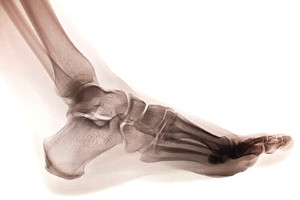Connect With Us
Blog
Items filtered by date: July 2023
Let the Expert Treat Your Ingrown Toenails
Foot Protection While at Work

Shoes are worn to protect the feet. Many working environments call for extra attention to be paid to the type of shoes that are worn during the workday. This is crucial in keeping the feet safe, as they can be exposed to dangerous circumstances. These can range from falling items to slipping on spills. Additionally, many people stand for the majority of the day, and this can put stress on their feet. Foot fatigue is common after a day’s work, and it is helpful if it is addressed. It may happen as a result of wearing shoes that do not fit well, which may cause the foot muscles to become tired. Research has indicated that lacerations, sprains and punctures account for about 10 percent of disabling injuries. The severity of these injuries may be reduced when boots are worn that have a steel toe. If you are interested in learning more about foot protection during the workday, it is suggested that you confer with a podiatrist who can answer any questions you may have.
While working on the feet, it is important to take the proper care of them. For more information about working on your feet, contact Pedram Aslmand, DPM from Advanced Foot and Ankle Center. Our podiatrist will treat your foot and ankle needs.
Working on Your Feet
Standing on your feet for long periods of time can cause stress and pain in your feet. Your whole body may experience change in terms of posture, back pain, bunions, callouses and or plantar warts. There are ways to avoid these conditions with proper foot care, smart choices and correct posture.
Positive Changes
Negative heeled shoe – Choosing this shoe type places the heel slightly lower than the ball of the foot. These are great for overall foot health. Find shoes that fit you correctly.
Go barefoot – Our feet were not designed to be enclosed for all hours of the day. Try to periodically expose your feet to air.
Eliminate Pain
Foot Exercises – Performing simple exercises, incorporating yoga and doing stretches are beneficial. This will allow increased blood flow to the area and muscles of the foot.
Achilles tendon – Stretching the foot out flat on the floor will relax the calf muscles and tendon. These exercises can be performed almost anywhere. Make sure you add these exercises to your daily regimen.
With a little bit of this information and knowing more about foot health, you will notice changes. Foot stretches and proper footwear will help with pain and prevent further issues.
If you have any questions please feel free to contact our offices located in Long Beach, CA . We offer the newest diagnostic and treatment technologies for all your foot and ankle needs.
How a Stress Fracture Occurs

Having tired muscles in the feet can cause a stress fracture to occur. These muscles can become fatigued by increasing speed and distance too quickly while running, which may cause the inability to absorb shock. The stress can be placed on the foot bones, possibly leading to a stress fracture. A common symptom of a stress fracture can consist of gradual pain while walking or running, which may decrease when activity is temporarily stopped. The area may also feel tender when touched, and this may propel patients to seek medical treatment. This often begins with resting the affected foot, and many people choose to wear a protective boot or cast that can encourage mobility. The average recovery time is between six and eight weeks, and it may help to pursue non-impact activities. If you have foot pain, and fear you may have a stress fracture, it is suggested that you confer with a podiatrist who can accurately diagnose and treat this condition.
Activities where too much pressure is put on the feet can cause stress fractures. To learn more, contact Pedram Aslmand, DPM from Advanced Foot and Ankle Center. Our podiatrist can provide the care you need to keep your pain free and on your feet.
Dealing with Stress Fractures of the Foot and Ankle
Stress fractures occur in the foot and ankle when muscles in these areas weaken from too much or too little use. The feet and ankles then lose support when walking or running from the impact of the ground. Since there is no protection, the bones receive the full impact of each step. Stress on the feet can cause cracks to form in the bones, thus creating stress fractures.
What Are Stress Fractures?
Stress fractures occur frequently in individuals whose daily activities cause great impact on the feet and ankles. Stress factors are most common among:
- Runners
- People affected with Osteoporosis
- Tennis or basketball players
- Gymnasts
- High impact workouts
Symptoms
Pain from the fractures occur in the area of the fractures and can be constant or intermittent. It will often cause sharp or dull pain with swelling and tenderness. Engaging in any kind of activity which involves high impact will aggravate pain.
If you have any questions please feel free to contact our offices located in Long Beach, CA . We offer the newest diagnostic and treatment technologies for all your foot and ankle needs.
First Sign of Plantar Fasciitis

One of the first signs of plantar fasciitis is heel pain. This pain will gradually worsen if medical attention is not promptly received. Plantar fasciitis is an inflamed or irritated plantar fascia, the band of tissue connecting the heel to the toes. It is instrumental in pointing and flexing the foot, which is crucial in completing daily activities. This condition can happen from standing on hard or uneven surfaces for long periods of time, or from wearing shoes that do not fit correctly. Mild relief may be found when the foot is rested and elevated, and gentle heel stretches are performed. An effective stretch consists of standing on a step while lowering one heel at a time and repeating for several repetitions. Some people may find it temporarily helps to wear a night splint, which can naturally stretch the calf, heel, and arch. If you have heel pain, it is strongly suggested that you are under the care of a podiatrist who can provide you with more permanent solutions.
Plantar fasciitis is a common foot condition that is often caused by a strain injury. If you are experiencing heel pain or symptoms of plantar fasciitis, contact Pedram Aslmand, DPM from Advanced Foot and Ankle Center. Our podiatrist can provide the care you need to keep you pain-free and on your feet.
What Is Plantar Fasciitis?
Plantar fasciitis is one of the most common causes of heel pain. The plantar fascia is a ligament that connects your heel to the front of your foot. When this ligament becomes inflamed, plantar fasciitis is the result. If you have plantar fasciitis you will have a stabbing pain that usually occurs with your first steps in the morning. As the day progresses and you walk around more, this pain will start to disappear, but it will return after long periods of standing or sitting.
What Causes Plantar Fasciitis?
- Excessive running
- Having high arches in your feet
- Other foot issues such as flat feet
- Pregnancy (due to the sudden weight gain)
- Being on your feet very often
There are some risk factors that may make you more likely to develop plantar fasciitis compared to others. The condition most commonly affects adults between the ages of 40 and 60. It also tends to affect people who are obese because the extra pounds result in extra stress being placed on the plantar fascia.
Prevention
- Take good care of your feet – Wear shoes that have good arch support and heel cushioning.
- Maintain a healthy weight
- If you are a runner, alternate running with other sports that won’t cause heel pain
There are a variety of treatment options available for plantar fasciitis along with the pain that accompanies it. Additionally, physical therapy is a very important component in the treatment process. It is important that you meet with your podiatrist to determine which treatment option is best for you.
If you have any questions, please feel free to contact our offices located in Long Beach, CA . We offer the newest diagnostic and treatment technologies for all your foot care needs.
Caring for Your Feet When You Have Diabetes

Diabetes is a condition that results in erratic blood sugar levels in the body. It is not an easy disease to navigate. It can have widespread effects on the body, including feeling and blood flow to the feet. Beyond managing blood sugar levels, it is important to examine your feet regularly looking for any cuts, sores, calluses, or changes to your skin or nails. A diabetic can develop neuropathy, making it hard to detect sensations in their extremities, such as pain. If this is difficult to do, a handheld mirror can help, as can asking a family member or care provider for assistance. Participating in regular physical activity and eating healthy can help keep blood sugar within a normal range. Problems brewing on the feet of a diabetic can turn into serious issues with life-threatening consequences. Those with diabetes can develop peripheral artery disease or poor blood flow to the feet, which puts them at risk for foot ulcers, gangrene, and tissue death. If you have diabetes, it is suggested that you visit a podiatrist regularly to have your feet examined as well as obtain prompt treatment for any problems that arise.
Diabetic foot care is important in preventing foot ailments such as ulcers. If you are suffering from diabetes or have any other concerns about your feet, contact Pedram Aslmand, DPM from Advanced Foot and Ankle Center. Our podiatrist can provide the care you need to keep you pain-free and on your feet.
Diabetic Foot Care
Diabetes affects millions of people every year. The condition can damage blood vessels in many parts of the body, especially the feet. Because of this, taking care of your feet is essential if you have diabetes, and having a podiatrist help monitor your foot health is highly recommended.
The Importance of Caring for Your Feet
- Routinely inspect your feet for bruises or sores.
- Wear socks that fit your feet comfortably.
- Wear comfortable shoes that provide adequate support.
Patients with diabetes should have their doctor monitor their blood levels, as blood sugar levels play such a huge role in diabetic care. Monitoring these levels on a regular basis is highly advised.
It is always best to inform your healthcare professional of any concerns you may have regarding your feet, especially for diabetic patients. Early treatment and routine foot examinations are keys to maintaining proper health, especially because severe complications can arise if proper treatment is not applied.
If you have any questions please feel free to contact our offices located in Long Beach, CA . We offer the newest diagnostic and treatment technologies for all your foot and ankle needs.


